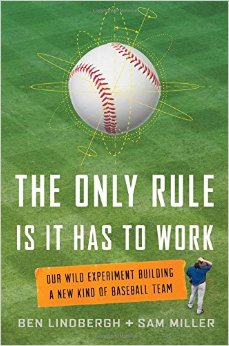"The Only Rule Is It Has to Work" Book Writeup
June 06, 2016
 The Only Rule Is It Has to Work: Our Wild Experiment Building a New Kind of Baseball Team
Ben Lindbergh, Sam Miller
ISBN: 1627795642
The Only Rule Is It Has to Work: Our Wild Experiment Building a New Kind of Baseball Team
Ben Lindbergh, Sam Miller
ISBN: 1627795642
What’s the point?
“Moneyball” happened; but the adoption of sports analytics is still not as pervasive as folks would imagine. This book chronicles what happens two stats geeks are given the reins of a professional baseball team. They can try any innovative tactics they want…the only rule is that is has to work.
How was it?
Ignore the baseball angle for a second. Without the backdrop of America’s pastime, this is the story of a traditional organization trying to become data-driven.
It’s one thing to get people to buy into data-driven thinking (props to Brad Pitt for doing his part), but Lindbergh and Miller stumble upon two unexpected challenges that arise when trying to use statistics and scientific approaches to making organizational decisions.
First, people assume that the “data” part of “data-driven” is readily available, accurate, well-formated, and ready for analysis.
For our intrepid baseball heroes, getting even basic historical statistics in their independent minor league was nearly impossible. In the MLB, every pitch, hit, player movement, and obnoxious bat flip is meticulously tracked with a combination of expensive cameras and a cottage industry of stat keepers. Lindbergh and Miller spend a large chunk of time (and call in personal favors) to equip their team with the bare necessities to collect the data they want before they can start letting the data “drive” decisions.
In a business context, you will face the same challenge. Want to be more analytical in your hiring pipeline? Well, have you been tracking leads at college career fairs, success rate for phone screenings, the life-time value of hired employees, performance of your job postings, and anything else you think might be useful? No? There is a large upfront cost to get this setup that should not be overlooked.
The second challenge is that your newly informed (and crazy sounding) decisions needs to be successful to convert skeptics. It has to work.
Applying an unconventional (but statistically sound) defensive shift might be the right process, but if the result is that the batter beats the odds and makes you look silly, it might be hard to recover credibility.
People are not always rational. No matter how much data we have support our case, emotion can still prevail. If an A/B test shows that a baby picture of the CEO on your homepage increases sales by 5% – but causes mortal embarrassment when the CEO shows his colleagues – it will be an uphill battle to deploy this change. Getting a few quick wins builds trust that can weather bad results.
By remembering that humans are not actually a collection of data points and statistics, we can be more deliberate about how we present data-driven analysis to build support and buy-in. Frame analytics as a way to help people improve their performance and achieve their goals, not an ivory tower from which to micromanage.
Who should read it?
Even if you find baseball to be mind-numbingly boring (raises hand), this book has a great story and highlights an often neglected aspect of becoming a data-driven organization: the tension between your cold, analytical model and the warm fuzzies of personal interactions.
